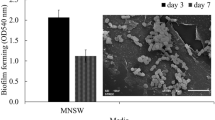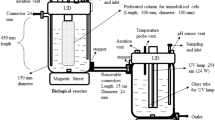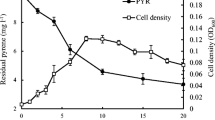Abstract
Pseudoxanthomonas sp. RN402 was capable of degrading diesel, crude oil, n-tetradecane and n-hexadecane. The RN402 cells were immobilized on the surface of high-density polyethylene plastic pellets at a maximum cell density of 108 most probable number (MPN) g−1 of plastic pellets. The immobilized cells not only showed a higher efficacy of diesel oil removal than free cells but could also degrade higher concentrations of diesel oil. The rate of diesel oil removal by immobilized RN402 cells in liquid culture was 1,050 mg l−1 day−1. Moreover, the immobilized cells could maintain high efficacy and viability throughout 70 cycles of bioremedial treatment of diesel-contaminated water. The stability of diesel oil degradation in the immobilized cells resulted from the ability of living RN402 cells to attach to material surfaces by biofilm formation, as was shown by CLSM imaging. These characteristics of the immobilized RN402 cells, including high degradative efficacy, stability and flotation, make them suitable for the purpose of continuous wastewater bioremediation.





Similar content being viewed by others
References
Agarry SE, Solomon BO, Layokun SK (2008) Substrate inhibition kinetics of phenol degradation by binary mixed culture of Pseudomonas aeruginosa and Pseudomonas fluorescence from steady state and wash-out data. African J Biotechnol 7:3927–3933. doi:10.5897/ajb08.673
Beilen JB, Funhoff EG, Loon A, Just A, Kaysser L, Bouza M, Holtackers R, Röthlisberger M, Li Z, Witholt B (2006) Cytochrome P450 alkane hydroxylases of the CYP153 family are common in alkane-degrading eubacteria lacking integral membrane alkane hydroxylases. Appl Environ Microbiol 72(1):59–65. doi:10.1128/aem.72.1.59-65.2006
Cappelletti M, Fedi S, Frascari D, Ohtake H, Turner RJ, Zannoni D (2011) Analyses of both the alkB gene transcriptional start site and alkB promoter-inducing properties of Rhodococcus sp. strain BCP1 grown on n-alkanes. Appl Environ Microbiol 77(5):1619–1627. doi:10.1128/aem.01987-10
Castorena G, Acuna ME, Aburto J, Bustos-Jaimes I (2008) Semi-continuous biodegradation of carbazole in fuels by biofilm immobilized cells of Burkholderia sp. strain IMP5GC. Process Biochem 43:1318–1321. doi:10.1016/j.procbio.2008.07.010
Chandran P, Das N (2011) Degradation of diesel oil by immobilized Candida tropicalis and biofilm formed on gravels. Biodegradation 22(6):1181–1189. doi:10.1007/s10532-011-9473-1
Chavan A, Mukherji S (2008) Treatment of hydrocarbon-rich wastewater using oil degrading bacteria and phototrophic microorganisms in rotating biological contactor: effect of N:P ratio. J Hazard Mater 154(1–3):63–72. doi:10.1016/j.jhazmat.2007.09.106
Das N, Chandran P (2011) Microbial degradation of petroleum hydrocarbon contaminants: an overview. Biotechnol Res Int 13: doi:10.4061/2011/941810
Djefal-Kerrar A, Abdoun KO, Chouikrat R, El-Kahina RG, Khodja AJ, Mahlous M (2011) Study of bacterium fixation stability on gamma radiation synthesized carriers to improve degradation. J Bioremed Biodegrad 2:117. doi:10.4172/per2155-6199.1000117
Hong JH, Kim J, Choi OK, Cho K-S, Ryu HW (2005) Characterization of a diesel-degrading bacterium, Pseudomonas aeruginosa IU5, isolated from oil-contaminated soil in Korea. World J Microbiol Biotechnol 21(3):381–384. doi:10.1007/s11274-004-3630-1
Huang L, Ma T, Li D, Liang F-l, Liu R-L, Li G-q (2008) Optimization of nutrient component for diesel oil degradation by Rhodococcus erythropolis. Mar Pollut Bull 56(10):1714–1718. doi:10.1016/j.marpolbul.2008.07.007
Kaczorek E, Urbanowicz M, Olszanowski A (2010) The influence of surfactants on cell surface properties of Aeromonas hydrophila during diesel oil biodegradation. Colloid Surf B 81(1):363–368. doi:10.1016/j.colsurfb.2010.07.039
Karabika E, Kallimanis A, Dados A, Pilidis G, Drainas C, Koukkou A (2009) Taxonomicidentification and use of free and entrapped cells of a new Mycobacterium sp., strain spyr1 for degradation of polycyclic aromatic hydrocarbons (PAHs). Appl Biochem Biotechnol 159(1):155–167. doi:10.1007/s12010-008-8463-1
Kayode-Isola TM, Eniola KIT, Olayemi AB, Igunnugbemi OO (2008) Response of resident bacteria of a crude oil-polluted river to diesel oil. American-Eurasian J Agron 1:6–9
Klankeo P, Nopcharoenkul W, Pinyakong O (2009) Two novel pyrene-degrading Diaphorobacter sp. and Pseudoxanthomonas sp. isolated from soil. J Biosci Bioeng 108(6):488–495. doi:10.1016/j.jbiosc.2009.05.016
Kloos K, Munch JC, Schloter M (2006) A new method for the detection of alkane-monooxygenase homologous genes (alkB) in soils based on PCR-hybridization. J Microbiol Meth 66(3):486–496. doi:10.1016/j.mimet.2006.01.014
Kohno T, Sugimoto Y, Sei K, Mori K (2002) Design of PCR primers and gene probes for general detection of alkane-degrading bacteria. Microbes Environ 17:114–121. doi:10.1264/jsme2.17.114
Kumari K, Sharma P, Tyagi K, Lal R (2011) Pseudoxanthomonas indica sp. nov., isolated from a hexachlorocyclohexane dumpsite. Int J Syst Evol Microbiol 61:2107–2111. doi:10.1099/ijs.0.017624-0
Lawniczak L, Kaczorek E, Olszanowski A (2011) The influence of cell immobilization by biofilm forming on the biodegradation capabilities of bacterial consortia. World J Microbiol Biotechnol 27(5):1183–1188. doi:10.1007/s11274-010-0566-5
Lee DS, Ryu SH, Hwang HW, Kim YJ, Park M, Lee JR, Lee SS, Jeon CO (2008) Pseudoxanthomonas sacheonensis sp. nov., isolated from BTEX-contaminated soil in Korea, transfer of Stenotrophomonas dokdonensis Yoon et al. 2006 to the genus Pseudoxanthomonas as Pseudoxanthomonas dokdonensis comb. nov. and emended description of the genus Pseudoxanthomonas. Int J Syst Evol Microbiol 58:2235–2240. doi:10.1099/ijs.0.65678-0
Lee Y-C, Shin H-J, Ahn Y, Shin M-C, Lee M, Yang J-W (2010) Biodegradation of diesel by mixed bacteria immobilized onto a hybrid support of peat moss and additives: a batch experiment. J Hazard Mater 183(1–3):940–944. doi:10.1016/j.jhazmat.2010.07.028
Li Y-Q, Liu H-F, Tian Z-L, Zhu L-H, Wu Y-H, Tang H-Q (2008) Diesel pollution biodegradation: synergetic effect of Mycobacterium and filamentous fungi. Biomed Environ Sci 21(3):181–187. doi:10.1016/s0895-3988(08)60026-4
Li SQ, Zhou PJ, Ding L, Feng K (2011) Treatment of oily wastewater using composite flocculant of polysilicate ferro-aluminum sulfate–rectorite. J Water Resource Protect 3(4):253–261. doi:10.4236/jwarp.2011.34032
Liu YJ, Zhang AN, Wang XC (2009) Biodegradation of phenol by using free and immobilized cells of Acinetobacter sp. XA05 and Sphingomonas sp. FG03. Biochem Eng J 44(2–3):187–192. doi:10.1016/j.bej.2008.12.001
Lohi A, Alvarez Cuenca M, Anania G, Upreti SR, Wan L (2008) Biodegradation of diesel fuel-contaminated wastewater using a three-phase fluidized bed reactor. J Hazard Mater 154(1–3):105–111. doi:10.1016/j.jhazmat.2007.10.001
Mahanty B, Pakshirajan K, Dasu V (2006) Production and properties of a biosurfactant applied to polycyclic aromatic hydrocarbon solubilization. Appl Biochem Biotechnol 134(2):129–141. doi:10.1385/abab:134:2:129
Marín MM, Smits THM, Beilen JB, Rojo F (2001) The alkane hydroxylase gene of Burkholderia cepacia RR10 Is under catabolite repression control. J Bacteriol 183(14):4202–4209. doi:10.1128/jb.183.14.4202-4209.2001
Nayak AS, Sanjeev Kumar S, Santosh Kumar M, Anjaneya O, Karegoudar TB (2011) A catabolic pathway for the degradation of chrysene by Pseudoxanthomonas sp. PNK-04 FEMS. Microbiol Lett 320(2):128–134. doi:10.1111/j.1574-6968.2011.02301.x
Nopcharoenkul W, Pinphanichakarn P, Pinyakong O (2011) The development of a liquid formulation of Pseudoxanthomonas sp. RN402 and its application in the treatment of pyrene-contaminated soil. J Appl Microbiol 111(1):36–47. doi:10.1111/j.1365-2672.2011.05037.x
Patel V, Cheturvedula S, Madamwar D (2012) Phenanthrene degradation by Pseudoxanthomonas sp. DMVP2 isolated from hydrocarbon contaminated sediment of Amlakhadi canal, Gujarat, India. J Hazard Mater 201–202:43–51. doi:10.1016/j.jhazmat.2011.11.002
Quek E, Ting YP, Tan HM (2006) Rhodococcus sp. F92 immobilized on polyurethane foam shows ability to degrade various petroleum products. Bioresour Technol 97(1):32–38. doi:10.1016/j.biortech.2005.02.031
Sivan A, Szanto M, Pavlov V (2006) Biofilm development of the polyethylene-degrading bacterium Rhodococcus ruber. Appl Microbiol Biotechnol 72(2):346–352. doi:10.1007/s00253-005-0259-4
Tyagi M, da Fonseca M, de Carvalho C (2011) Bioaugmentation and biostimulation strategies to improve the effectiveness of bioremediation processes. Biodegradation 22(2):231–241. doi:10.1007/s10532-010-9394-4
Vieira PA, Vieira RB, de França FP, Cardoso VL (2007) Biodegradation of effluent contaminated with diesel fuel and gasoline. J Hazard Mater 140(1–2):52–59. doi:10.1016/j.jhazmat.2006.06.048
Wang L, Wang W, Lai Q, Shao Z (2010a) Gene diversity of CYP153A and AlkB alkane hydroxylases in oil-degrading bacteria isolated from the Atlantic Ocean. Environ Microbiol 12(5):1230–1242. doi:10.1111/j.1462-2920.2010.02165.x
Wang ZZ, Liu XY, Zhang XY, Wang J, Cao ZN, Zhong CL, Su PC (2010b) Wetland bacteria isolated from Huangpu river-Yangtze river estuary and its degradation on diesel. J Shanghai Univ 14(4):292–296. doi:10.1007/s11741-010-0646-1
Wang GL, Bi M, Liang B, Jiang JD, Li SP (2011a) Pseudoxanthomonas jiangsuensis sp. Nov., a DDT-degrading bacterium isolated from a long-term DDT-polluted soil. Curr Microbiol 62(6):1760–1766. doi:10.1007/s00284-011-9925-1
Wang XB, Chi CQ, Nie Y, Tang YQ, Tan Y, Wu G, Wu XL (2011b) Degradation of petroleum hydrocarbons (C6–C40) and crude oil by a novel Dietzia strain. Bioresour Technol 102(17):7755–7761. doi:10.1016/j.biortech.2011.06.009
Wongsa P, Tanaka M, Ueno A, Hasanuzzaman M, Yumoto I, Okuyama H (2004) Isolation and characterization of novel strains of Pseudomonas aeruginosa and Serratia marcescens possessing high efficiency to degrade gasoline, kerosene, diesel oil, and lubricating oil. Curr Microbiol 49:415–422. doi:10.1007/s00284-004-4347-y
Wu L, Ge G, Wan J (2009) Biodegradation of oil wastewater by free and immobilized Yarrowia lipolytica W29. J Environ Sci 21(2):237–242. doi:10.1016/s1001-0742(08)62257-3
Acknowledgments
This work was supported by grants from the Office of the National Research Council of Thailand, the Office of the Higher Education Commission, Thailand, the 90th Anniversary of Chulalongkorn University Fund (Ratchadaphiseksomphot Endowment Fund), Chulalongkorn University, and the Thai Government Stimulus Package 2 (TKK2555) under the Project for the Establishment of the Comprehensive Center for Innovative Food, Health Products and Agriculture.
Author information
Authors and Affiliations
Corresponding author
Electronic supplementary material
Below is the link to the electronic supplementary material.
Rights and permissions
About this article
Cite this article
Nopcharoenkul, W., Netsakulnee, P. & Pinyakong, O. Diesel oil removal by immobilized Pseudoxanthomonas sp. RN402. Biodegradation 24, 387–397 (2013). https://doi.org/10.1007/s10532-012-9596-z
Received:
Accepted:
Published:
Issue Date:
DOI: https://doi.org/10.1007/s10532-012-9596-z




